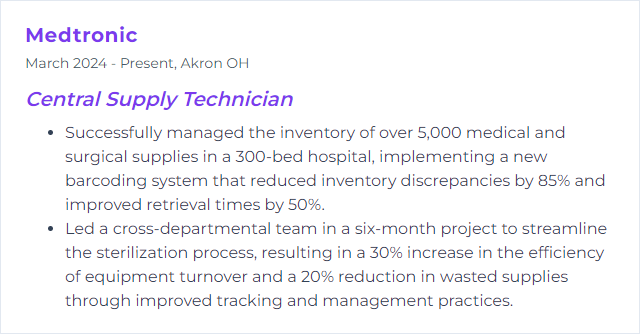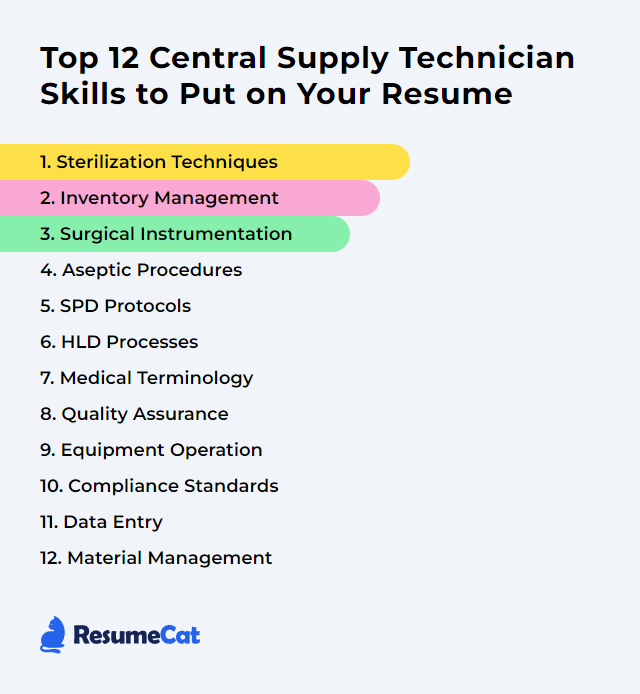Top 12 Central Supply Technician Skills to Put on Your Resume
Central Supply Technicians keep hospitals humming. Sterile instruments arrive on time. Trays are complete. Risks stay low. A sharp resume that blends technical know-how, precise organization, and clear communication helps you stand out in a role where details can ripple into patient outcomes.
Central Supply Technician Skills
- Sterilization Techniques
- Inventory Management
- Surgical Instrumentation
- Aseptic Procedures
- SPD Protocols
- HLD Processes
- Medical Terminology
- Quality Assurance
- Equipment Operation
- Compliance Standards
- Data Entry
- Material Management
1. Sterilization Techniques
Sterilization techniques remove all forms of microbial life from instruments and devices—bacteria, viruses, fungi, spores. Steam (autoclave), low-temperature hydrogen peroxide systems, ethylene oxide, and dry heat each have their place. Use the right method for the device, the materials, and the instructions for use.
Why It's Important
No shortcuts here. Effective sterilization blocks device-related infections, protects patients and staff, and anchors trust in every procedure that follows.
How to Improve Sterilization Techniques Skills
Keep sharpening your edge through practice and policy:
Stay current: Review updates from recognized authorities (e.g., AAMI, CDC, manufacturers) and align procedures with the latest evidence and standards.
Hands-on training: Master each sterilizer’s cycles, loading patterns, and monitoring requirements. Validate competency regularly.
Quality monitoring: Use biological indicators, chemical integrators, and physical monitoring. Trend results. Act fast on any excursion.
Maintenance and validation: Follow manufacturer schedules for inspection, calibration, and performance qualification.
Prep with precision: Cleaning, rinsing, drying, assembly, and packaging must be flawless—sterilization cannot fix soil left behind.
It’s a loop: educate, execute, verify, improve.
How to Display Sterilization Techniques Skills on Your Resume

2. Inventory Management
Inventory management means knowing what you have, where it sits, how fast it moves, and when to replenish—while meeting clinical demand without bloat or stockouts.
Why It's Important
Right item, right time, right quantity. Fewer expired supplies, less waste, fewer delays. Smooth operations depend on it.
How to Improve Inventory Management Skills
Build clarity and flow:
Automate tracking: Use inventory software with par levels, usage reports, and alerts. Data beats guesswork.
Apply FIFO/FEFO: Move older or earlier-expiring products first to reduce waste.
Cycle counts: Frequent small counts catch errors early and keep records accurate.
Organize visually: Clear labels, bin locations, standardized naming, and 5S principles speed retrieval and reduce picking mistakes.
Write it down: SOPs for receiving, stocking, and issuing supplies keep everyone consistent—then train to those SOPs.
How to Display Inventory Management Skills on Your Resume

3. Surgical Instrumentation
From clamps to scopes, surgical instrumentation requires meticulous cleaning, inspection, assembly, packaging, and sterilization. Know the names, the functions, and the pitfalls that lead to damage or delays.
Why It's Important
Safe, complete sets keep operating rooms on schedule and patients protected. One missing or malfunctioning instrument can upend a case.
How to Improve Surgical Instrumentation Skills
Raise the bar through routine and rigor:
Follow IFUs and standards: Adhere to device instructions and established guidance (e.g., AAMI). No improvisation.
Prevent damage: Use protective sleeves, proper brushing techniques, and correct tray layouts. Inspect under magnification when needed.
Track repairs: Log damage trends, schedule maintenance, and remove compromised tools promptly.
Credentialing and education: Earn or maintain certifications (e.g., CBSPD, HSPA) and refresh knowledge through in-services.
Quality checkpoints: Independent verification for count sheets, functionality testing, and sterilization parameters.
How to Display Surgical Instrumentation Skills on Your Resume

4. Aseptic Procedures
Aseptic procedures block contamination at every handoff—cleaning, packaging, storage, and transport. Technique matters. So does environment.
Why It's Important
When asepsis falters, infections rise. Consistent practice keeps instruments and areas free from unintended microbes.
How to Improve Aseptic Procedures Skills
Make sterile the default:
- Ongoing training: Refresh aseptic principles regularly and validate competencies.
- Strict protocol adherence: Cleaning, disinfection, sterilization, and storage steps performed exactly as written.
- Equipment oversight: Test and document sterilizer and washer performance; act on alarms and failures immediately.
- Indicator use: Chemical and biological indicators verify process success—review and retain records.
- Clean zones: Keep areas tidy, separated by workflow (dirty to clean), with enforced traffic patterns.
- Hand hygiene and PPE: Non-negotiable, every time.
How to Display Aseptic Procedures Skills on Your Resume
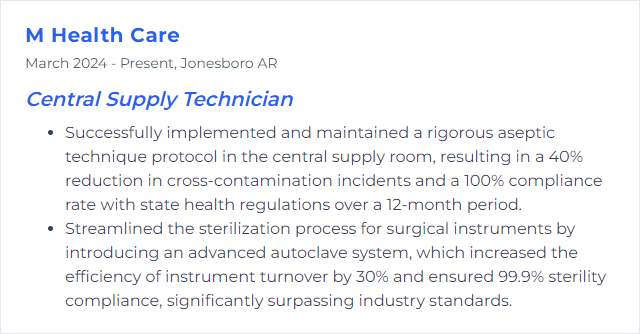
5. SPD Protocols
SPD protocols are the step-by-step rules for decontamination, inspection, assembly, packaging, sterilization, storage, and distribution. They align with standards such as AAMI ST79, manufacturer instructions, and facility policy.
Why It's Important
Standardized processes reduce variability, improve safety, and make outcomes predictable. That means fewer errors, smoother audits, and safer patients.
How to Improve SPD Protocols Skills
Strengthen the system and the team:
Education: Keep staff current on revised standards, IFUs, and equipment updates. Cross-train to build depth.
Standardize: Clear SOPs with visual aids and checklists. Simpler, fewer steps—done the same way every day.
Preventive maintenance: Schedule and document upkeep for sterilizers, washers, and testing devices.
Quality control: Use integrators, indicators, and load records; audit trays and documentation routinely.
Communication loops: Tight feedback with OR, clinics, and vendors to catch issues early and refine workflows.
Regulatory alignment: Map protocols to applicable requirements (e.g., CDC, FDA, AAMI) and keep gap assessments current.
How to Display SPD Protocols Skills on Your Resume
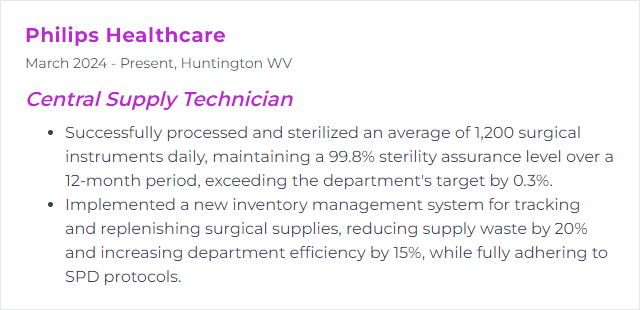
6. HLD Processes
High-Level Disinfection (HLD) destroys all microorganisms except a small number of bacterial spores. It’s used for semi-critical devices that contact mucous membranes when sterilization isn’t required or feasible.
Why It's Important
Correct HLD technique prevents patient harm during endoscopy, respiratory care, and other procedures that depend on impeccably processed devices.
How to Improve HLD Processes Skills
Dial in precision and consistency:
Training and competency: Validate staff on contact times, temperatures, concentrations, and rinsing protocols for each HLD method.
Standardize steps: From cleaning to final storage—document each action to remove guesswork.
Quality checks: Test solutions, record minimum effective concentrations, and audit logs. Trace every device to every cycle.
Leverage automation: Where possible, use automated reprocessors for reproducible cycles and better documentation.
Equipment care: Maintain reprocessors and testing tools on schedule; promptly address failures.
Feedback culture: Encourage reporting of near misses and suggestions; improve the process, not just the person.
How to Display HLD Processes Skills on Your Resume
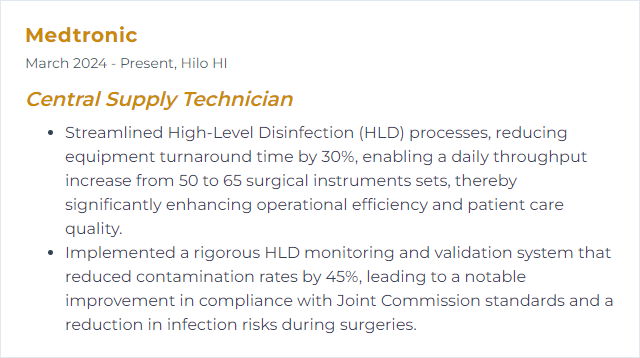
7. Medical Terminology
Medical terminology is the shorthand of healthcare. Knowing anatomy, device names, procedures, and abbreviations reduces errors and speeds communication.
Why It's Important
When requests are precise, fulfillment is faster. Misunderstanding a term can derail a case or delay care—accuracy matters.
How to Improve Medical Terminology Skills
Steady practice wins:
Daily exposure: Read preference cards, IFUs, and pick lists; note unfamiliar terms and look them up.
Flashcards and quizzes: Reinforce roots, prefixes, and common instrument names.
Peer learning: Huddles and in-services with OR and SPD staff cement practical vocabulary.
Context use: Apply terms while assembling sets or documenting work to lock in meaning.
Certification prep: Studying for CBSPD or HSPA exams boosts terminology and application.
How to Display Medical Terminology Skills on Your Resume
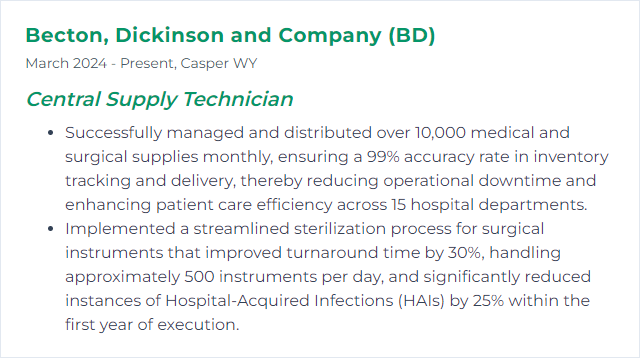
8. Quality Assurance
Quality Assurance in SPD means building systems that catch errors before patients ever see them—standardization, monitoring, documentation, and continuous improvement.
Why It's Important
QA preserves sterility, functionality, and completeness. It also strengthens survey readiness and clinical confidence.
How to Improve Quality Assurance Skills
Make quality visible:
Robust SOPs: Clear, version-controlled procedures for every task; easy to access at the point of use.
Training + revalidation: Initial competency, then periodic checks—especially after updates or incidents.
Process audits: Observe workflows, review records, and sample trays. Close gaps with corrective actions that stick.
Metrics that matter: Track BI pass rates, tray errors, turnaround times, and repair trends. Share results.
Feedback channels: Capture OR and clinic concerns; prioritize fixes and report back on outcomes.
How to Display Quality Assurance Skills on Your Resume
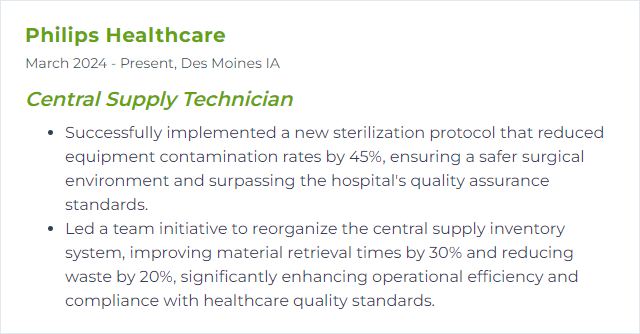
9. Equipment Operation
Equipment operation covers sterilizers, washers, ultrasonics, drying cabinets, and testing tools. Know the controls, the indicators, and the limits.
Why It's Important
When machines run right, processes are reliable. When they don’t, risk climbs and rework explodes.
How to Improve Equipment Operation Skills
Precision pays off:
Follow IFUs: Operate and load equipment exactly as designed; document deviations and resolve quickly.
Preventive maintenance: Schedule service, verify calibrations, and keep service records tidy and traceable.
Competency-based training: New hires and veterans alike benefit from refreshers and scenario-based drills.
Equipment logs: Record cycles, loads, alarms, and BI results; trend performance over time.
QA integration: Tie equipment data to quality metrics so small issues are spotted before they become large ones.
How to Display Equipment Operation Skills on Your Resume
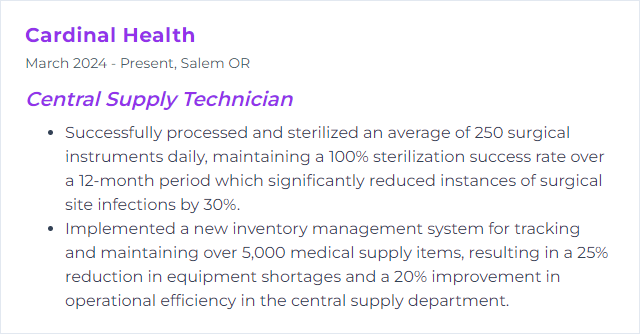
10. Compliance Standards
Compliance standards are the rules and guidance that govern safe processing and distribution—think CDC, FDA, AAMI, manufacturer IFUs, and your facility’s policies.
Why It's Important
Following the standard protects patients, shields staff, and sustains accreditation. It’s the baseline, not the ceiling.
How to Improve Compliance Standards Skills
Make compliance daily, not yearly:
Continuing education: Short refreshers, policy updates, and focused drills when standards change.
Protocol fidelity: Align SOPs to current guidance; retire outdated steps promptly.
Quality controls: Routine indicator use, record reviews, and traceability from load to patient area.
Audit rhythm: Internal spot checks and mock surveys reduce surprises when external reviewers arrive.
Documentation discipline: If it isn’t documented, it didn’t happen. Keep records legible, complete, and ready to retrieve.
How to Display Compliance Standards Skills on Your Resume

11. Data Entry
Data entry in SPD captures inventory, device movement, sterilization loads, indicators, maintenance, and distribution—clean data that tells the story of every item.
Why It's Important
Accurate records power recalls, audits, reorders, and patient safety investigations. Sloppy inputs create expensive confusion.
How to Improve Data Entry Skills
Aim for accuracy without slowing the line:
Standard fields and naming: Use consistent item names, units, and codes. Templates reduce typos.
Right tool, right workflow: Barcoding and scanning where possible; minimize manual entry.
Training + verification: Teach common error traps, then add peer checks for critical entries.
Routine audits: Sample records, compare to physical stock, and fix root causes.
Feedback loop: Make it easy to flag system issues or confusing fields and improve the form, not just the user.
How to Display Data Entry Skills on Your Resume
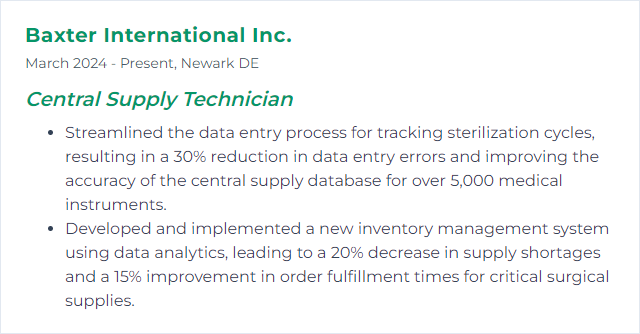
12. Material Management
Material (materials) management plans, sources, stores, and delivers the supplies and equipment care teams need—efficiently, safely, and at a reasonable cost.
Why It's Important
Stockouts delay care. Overstock drains budgets and shelf space. Smart control balances speed with stewardship.
How to Improve Material Management Skills
Tighten the supply chain end to end:
Inventory systems: Use software for real-time levels, usage, and reorder triggers. Set pars with clinical input.
Lean thinking: Remove wasted motion and excess stock. Just-in-time where feasible, with buffers for critical items.
Supplier partnerships: Clarify expectations on quality, lead times, and substitutions. Review performance regularly.
Standardization: Reduce item variation across departments to simplify stocking and cut costs.
Education and certification: Build skills in purchasing, contracting, and analytics to support smarter decisions.
Quality gates: Inspect on receipt, control storage conditions, and monitor expirations.
Data analytics: Forecast demand, spot slow movers, and identify savings opportunities with clear dashboards.
How to Display Material Management Skills on Your Resume
